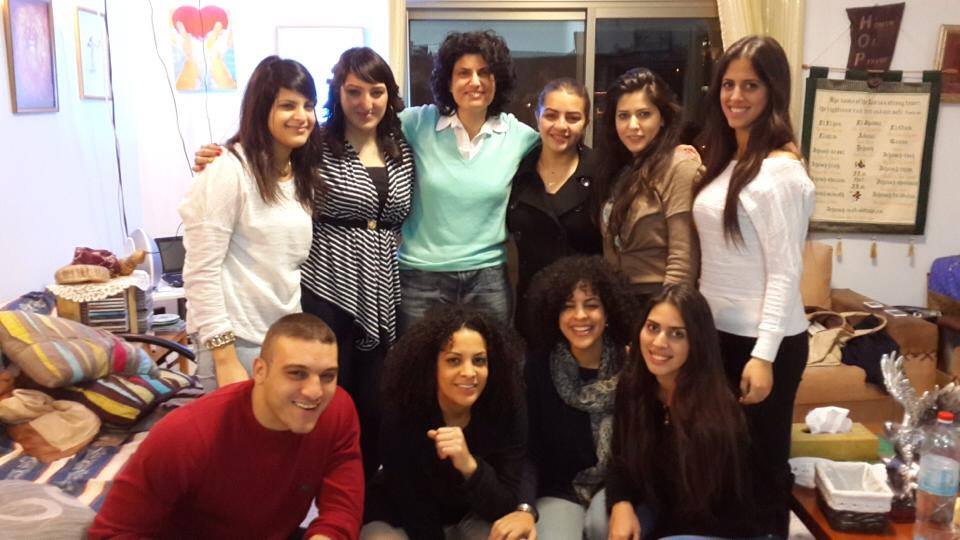On the 17th of February, HOPE hosted a Deborah’s Clan gathering of 48 Messianic Jewish and Arab spiritual mothers in the land. Karen Davis opened the conference by leading us into the presence of the Lord through worship in Hebrew and English. Rania then spoke about arising as Deborahs and Esthers in the land for such a time as this. She shared a word she had received from the Lord, “When the mothers of the land arise, there is safety in the land.” There is currently an escalation of war and tumult in the Israeli government, but as spiritual mothers we are the keys to the restoration within the land of Israel, and it is time for us to stand up as Esthers and take our place.
Rania received the date of 17/2 for bringing together Jewish and Arab sisters for prayer in Nazareth, and upon arrival each woman received a white stone either with a golden crown or the word “Malka“ (“queen” in Hebrew) painted on it. Esther 2:17 speaks of the crowning of Esther. Likewise, God is crowing us today with a royal crown to declare His authority, saying, “I want to release a new experience of my love upon each Esther present in this place and anoint her as a seal.” Revelation 2:17 speaks about a white stone with a new name written on it. It is God’s seal, as He is working strategically through the women taking their stand. On the new mural in Nazareth painted by an Israeli artist in cooperation with an Iranian-American filmmaker, it states, “It is time for the Esthers to arise!” This is a prophetic declaration for Esthers all over the world to stand against the spirit of Haman. When we are standing together as Arab and Messianic Jewish sisters, it will change everything in Israel.
Following Rania, Margaret Abu Ghazaleh shared a short message from John 13:3-5, emphasizing that our identity is not from here. Jesus knew while He was walking here on earth that His identity was not from this place, and neither is ours. We are daughters of the King!
After a short break, Rajaa Sadran opened the next session leading us in beautiful Arabic worship, followed by a couple of Messianic Jewish sisters sharing what the Lord had put on their hearts. Sarah Liberman first shared her personal testimony of how the Lord touched her heart in the middle of her struggle, as she as continued worshiping Him despite a hearing injury. One day she received a vision of the globe, with God’s eyes looking with fire on the Middle East, as she heard Him saying, “These are the people who are on my heart.” From that day on, God put it on Sarah’s heart to translate one of her songs into Arabic. However, before she got to do anything about it, she suddenly received a recording by Egyptians who had translated one of her songs from English into Arabic, sent to her by Canadian friends. Sarah Liberman at once felt like her namesake Sarah from the Bible, who had sent away her Egyptian maid Hagar and Ishmael. Realizing that the rejection of Hagar and Ishmael had caused the rise of Islam saying that, “Allah has no son,” Sarah felt she had to learn Arabic and ask for forgiveness in Arabic.
The final speaker was Orna Grinman. She continued speaking on the theme of Esther, who in the beginning of the story was introduced as “an object,” who did everything her uncle, Mordechai told her, whereas later she was the one telling him what to do. Haman had everything, but none of this had any value for him, as long as this one thing – Mordechai sitting at the gate – was disturbing him (Esther 5:13). Orna showed us illustratively the beautiful Bible scrolls her mother had left her, and opening the Scroll of Esther she declared that it was time for us to start writing our scroll! “God needs each of our hearts in His story. My scroll is really not my scroll, but each of us are writing it together,” Orna said. In the past, she had seen the Arab women as being unnecessary and “sitting at the gate” in her story. However, now she understood how important it was to the Lord that we were all gathered together. After Orna’s message, the Holy Spirit led us into a time of prayer and repentance toward one other, followed by Sarah Liberman singing “The Blessing” over us in English and Hebrew. Finally, before returning home, we all shared a time of beautiful fellowship over a delicious Arabic meal in the HOPE Café.

 There is a wealth of information that can be found here but if you still have any questions, please
There is a wealth of information that can be found here but if you still have any questions, please  Our goal is to bring people together, to grow with each other and to serve others. Click here if you want to meet some new people and
Our goal is to bring people together, to grow with each other and to serve others. Click here if you want to meet some new people and 






































